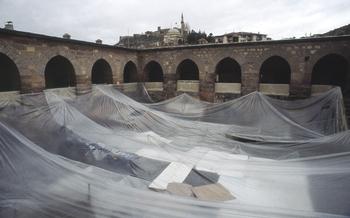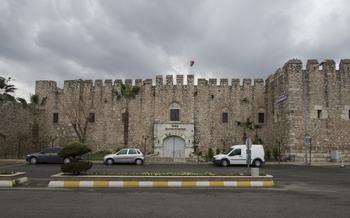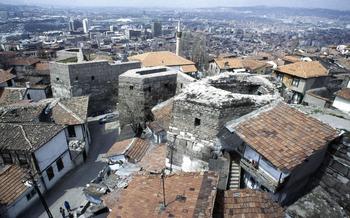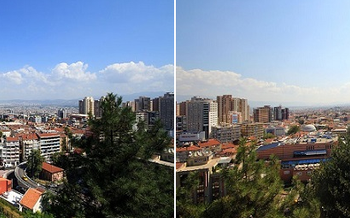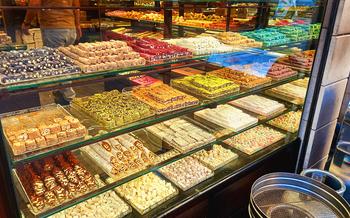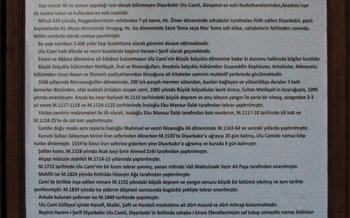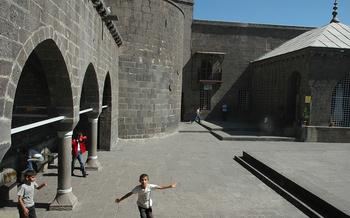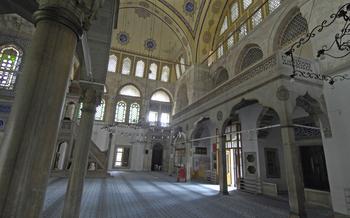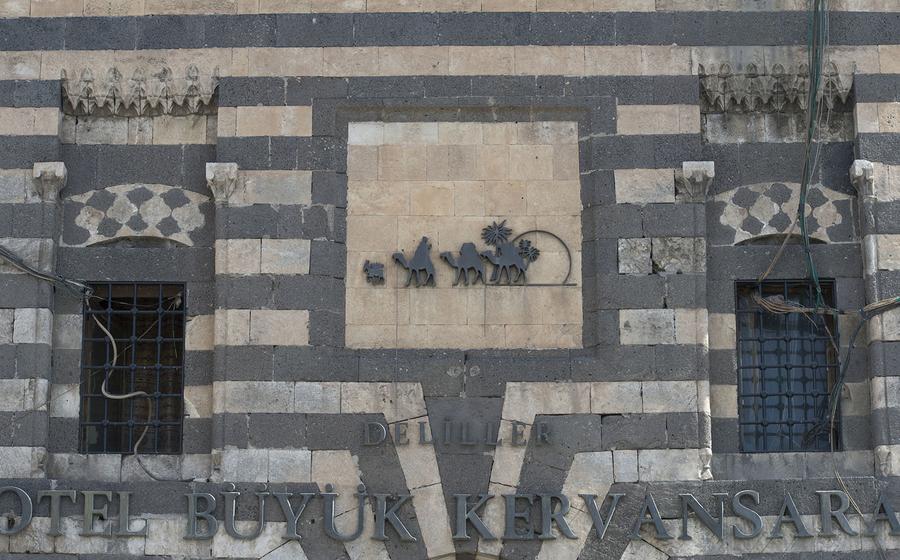
Deliller Hanı
- The Caravanserai of Diyarbakır:
- Location and Accessibility:
- Exploring the Courtyard
- The Rooms and Chambers
- Exploring the Hammam
- The Mosque and Prayer Room
- The Stables and Animal Quarters:
- The Workshops and Artisans
- The Kitchens and Dining Areas
- The Bazaar and Market Stalls
- The Gateways and Entrances
- The Water Systems and Cisterns
- The Cultural Significance
- Insider Tips for an Unforgettable Experience at the Deliller Hanı
The Caravanserai of Diyarbakır:
The Deliller Hanı, known as the Caravanserai of Diyarbakır, stands as a testament to the rich history and cultural heritage of this ancient city. Built in the 16th century during the reign of the Ottoman Empire, this caravanserai served as a vital hub for trade and commerce along the Silk Road. Its strategic location at the crossroads of major trade routes made it a bustling center for merchants, travelers, and pilgrims from across the region. The Deliller Hanı's architectural marvel and historical significance have earned it recognition as a UNESCO World Heritage Site, attracting visitors from around the globe.
Architectural Masterpiece:
The Deliller Hanı showcases remarkable architectural features that reflect the grandeur and functionality of a caravanserai. Its imposing stone walls, adorned with intricate carvings and inscriptions, speak of the artistry and craftsmanship of its builders. The central courtyard, surrounded by two-story galleries and arched iwans, creates a sense of spaciousness and grandeur. The rooms and chambers, designed to accommodate merchants and their goods, feature vaulted ceilings and decorative niches, providing both comfort and security. The caravanserai's design reflects the harmonious blend of Islamic and Anatolian architectural styles, making it a unique and captivating masterpiece.
Location and Accessibility:
Address: The Deliller Hanı is situated in the heart of Diyarbakır's old city, within the historic district known as İçkale. It can be found at the following address:
Deliller Hanı İçkale Mahallesi, Hükümet Caddesi No: 33/3 Diyarbakır, Turkey
Transportation: Diyarbakır is well-connected by air and land, making it easily accessible from within Turkey and abroad.
-
By Air: Diyarbakır Airport (DIY) is located approximately 5 kilometers from the city center. From the airport, you can take a taxi or public transportation to reach İçkale.
-
By Land: Diyarbakır is also accessible by bus or train from major cities in Turkey. Once in Diyarbakır, you can take a taxi or public transportation to reach the old city.
Distance from Major Cities:
- Ankara: 883 kilometers (approximately 10 hours by bus)
- Istanbul: 1,405 kilometers (approximately 18 hours by bus)
- İzmir: 1,520 kilometers (approximately 19 hours by bus)
Accessibility: The Deliller Hanı is generally accessible for visitors with disabilities. There are ramps and elevators that provide access to the courtyard and some of the chambers. However, some areas of the caravanserai may still be challenging to navigate for wheelchair users due to its historical nature.
Exploring the Courtyard
The central courtyard of the Deliller Hanı serves as the heart of the caravanserai, a place where merchants, travelers, and animals would gather, trade stories, and rest. Its spacious design allowed for the loading and unloading of goods, while providing ample space for socializing and conducting business.
The courtyard is surrounded by iwans, or vaulted halls, which provide shade and shelter from the elements. These iwans feature intricate carvings and decorative tiles, showcasing the architectural finesse of the era. The columns and arches that support the iwans add to the visual appeal of the courtyard, creating a sense of grandeur and elegance.
One of the most striking features of the courtyard is the ornate fountain, which once provided a refreshing source of water for the caravanserai's inhabitants. The fountain is adorned with delicate carvings and inscriptions, reflecting the artistic sensibilities of the time.
The courtyard also served as a gathering place for religious ceremonies and festivals. During important events, the courtyard would be decorated with colorful tapestries and lanterns, creating a vibrant and festive atmosphere.
The Rooms and Chambers
The Deliller Hanı offered a variety of rooms and chambers to accommodate merchants and travelers. These ranged from basic, windowless cells to more spacious and luxurious suites. The rooms were typically arranged around the central courtyard, with their entrances facing inward.
Each room was equipped with a simple bed, a few pillows, and a carpet or rug. Wealthier merchants might bring their own furnishings, such as mattresses, blankets, and chests. The rooms were also equipped with a small fireplace for heat and cooking, as well as a basin and pitcher for washing.
The Han also provided larger chambers for groups or families. These chambers were often located on the upper floors and featured multiple windows, providing ample light and ventilation. They were also more elaborately decorated, with carved wooden doors and painted ceilings.
Evidence of past occupants and their activities can still be found in the rooms of the Deliller Hanı. In some rooms, the walls are still covered in graffiti and inscriptions left by merchants and travelers. These inscriptions often include the names of the occupants, the dates of their stay, and their hometowns. In other rooms, the remains of old fireplaces, cooking utensils, and personal belongings can be found, providing a glimpse into the lives of those who once lived and worked in the caravanserai.
Today, the rooms of the Deliller Hanı are used for a variety of purposes. Some have been converted into exhibition spaces, where visitors can learn about the history of the caravanserai and the region. Others are used for events and workshops, providing a unique and atmospheric setting for cultural and educational programs.
Exploring the Hammam
Nestled within the courtyard of the Deliller Hanı, discover the historical hammam, a testament to the caravanserai's commitment to providing comfort and well-being to its guests. Step into this ancient bathing chamber and immerse yourself in its rich history and architectural splendor.
The hammam, also known as a Turkish bath, was an integral part of the caravanserai's facilities, offering weary travelers a chance to cleanse, relax, and rejuvenate after a long journey. Its design showcases traditional Islamic architecture, featuring intricate tilework, vaulted ceilings, and natural light filtering through strategically placed windows.
Experience the traditional bathing rituals that have been practiced in these hallowed chambers for centuries. Begin with a warm-up in the changing room, followed by a soothing steam in the hot room. Indulge in a traditional kese, a full-body scrub that removes impurities and dead skin, leaving you feeling refreshed and revitalized.
The hammam's centerpiece is the sıcaklık, or hot room, where bathers can recline on heated marble slabs and enjoy a massage or sabunlama, a luxurious soap massage that cleanses and nourishes the skin. The acoustics of the chamber create a unique and immersive experience, allowing you to fully relax and let go of the stresses of travel.
The Deliller Hanı's hammam is currently undergoing careful restoration to preserve its historical integrity while enhancing its functionality. Upon completion, visitors will be able to experience this ancient bathing tradition in its full glory, immersing themselves in the rich history, culture, and hospitality of Diyarbakır.
The Mosque and Prayer Room
Within the Deliller Hanı, a sacred space known as the mosque or prayer room holds significant religious and architectural importance. Located at the heart of the caravanserai, this serene sanctuary served as a place of worship and spiritual refuge for weary travelers and merchants. The mosque's design reflects the architectural style prevalent in the region, featuring a simple yet elegant prayer hall with intricate decorative elements.
The prayer room's interior is adorned with beautiful inscriptions and carvings, showcasing the artistry and craftsmanship of the past. The mihrab, a niche indicating the direction of Mecca, is a particularly striking feature, adorned with intricate tile work and calligraphy. The mosque's serene atmosphere and spiritual significance make it a place of tranquility and contemplation, inviting visitors to connect with the history and traditions of the region.
The Stables and Animal Quarters:
In the bustling caravanserai, the stables and animal quarters held a crucial place, serving as a vital component of the trade and transportation network. These meticulously designed spaces accommodated the diverse animals that accompanied merchants on their journeys. The stables provided secure shelter for horses, camels, and donkeys, the beasts of burden that carried goods across vast distances. With their sturdy construction and ample space, these quarters ensured the animals' well-being during their stay in the caravanserai.
The layout of the stables allowed for efficient movement and care of the animals. Separate sections were designated for different species, each designed to meet their specific needs. Mangers and water troughs were strategically placed to facilitate feeding and hydration, while ventilation systems ensured a comfortable environment for the animals. Evidence of past occupants can still be found in the stables, such as markings on the walls where animals were tethered or inscriptions left by their owners.
Today, the stables and animal quarters have been transformed into multifunctional spaces, hosting cultural events, exhibitions, and performances. These events breathe new life into the caravanserai, showcasing the rich cultural heritage of Diyarbakır and the enduring significance of the Deliller Hanı.
The Workshops and Artisans
The Deliller Hanı was not just a place for merchants to rest and trade; it was also a hub of creativity and craftsmanship. Artisans from various disciplines, such as woodworking, metalworking, leatherworking, and pottery, had their workshops within the caravanserai. These skilled craftsmen played a vital role in the economy of the han, producing goods that were not only sold to merchants but also used by the caravanserai itself.
The interaction between merchants and artisans was mutually beneficial. The merchants provided a steady stream of customers for the artisans, while the artisans supplied the merchants with high-quality goods that could be sold for a profit. This symbiotic relationship contributed to the overall success and prosperity of the Deliller Hanı.
The legacy of craftsmanship in Diyarbakır continues to this day. The city is renowned for its skilled artisans who produce exquisite carpets, textiles, jewelry, and pottery. Visitors to the Deliller Hanı can still witness the artisans at work in their workshops, continuing a tradition that has been passed down for generations.
The Kitchens and Dining Areas
The kitchens and dining areas of the Deliller Hanı played a vital role in the daily lives of the merchants and travelers who frequented the caravanserai. The kitchens, located in a separate section of the complex, were equipped with traditional ovens, hearths, and cooking utensils. Skilled chefs prepared a variety of dishes, using fresh ingredients from the local markets.
Merchants and travelers gathered in the communal dining areas to share meals and socialize. These dining areas were often located in the courtyard or in large, open rooms within the han. The meals were typically simple but hearty, consisting of traditional Turkish dishes such as kebabs, stews, and flatbreads.
Communal dining was an important social occasion for the merchants. It provided an opportunity for them to exchange news, share stories, and build relationships. The dining areas also served as a place for merchants to conduct business and negotiate deals.
Today, visitors to the Deliller Hanı can still experience the atmosphere of the old kitchens and dining areas. Several restaurants and cafes have been established within the complex, offering traditional Turkish cuisine and beverages. Visitors can enjoy a leisurely meal in the courtyard, surrounded by the historic architecture of the caravanserai, and savor the flavors of Diyarbakır's rich culinary heritage.
The Bazaar and Market Stalls
The courtyard of the Deliller Hanı also housed a bustling bazaar, a vibrant hub of trade and commerce. Merchants from far and wide set up their stalls, displaying an array of goods and products that catered to the needs of travelers, locals, and traders. From exquisite textiles and carpets to gleaming copperware and intricately carved woodwork, the bazaar offered a kaleidoscope of colors, textures, and aromas. The air was filled with the sounds of haggling, bargaining, and the cheerful banter of customers and vendors.
Visitors could find everything they needed within the caravanserai's market, from spices and herbs to dried fruits and nuts, as well as a variety of local delicacies. Artisans showcased their skills, crafting unique souvenirs and handmade goods that reflected the rich cultural heritage of Diyarbakır. The bazaar was not just a place of commerce but also a social gathering point, where people from different backgrounds and cultures came together to exchange stories, news, and ideas.
The Gateways and Entrances
The gateways and entrances of the Deliller Hanı held immense significance in ensuring the security and protection of the caravanserai. These intricate structures were designed with defensive mechanisms and fortifications to safeguard the merchants and their goods from potential threats. The main entrance, adorned with imposing arches and sturdy doors, served as a grand portal for travelers to enter the han. Smaller entrances, strategically positioned throughout the complex, allowed for controlled access and movement of people and animals. The intricate lock systems, along with the presence of watchtowers and guards, further enhanced the security measures. The gateways of the Deliller Hanı not only provided practical protection but also held symbolic meaning, representing the importance of safety and hospitality in the caravanserai's culture.
The Water Systems and Cisterns
The Deliller Hanı, like many other caravanserais, placed great importance on access to water, a vital resource for survival and trade. The caravanserai was equipped with an elaborate water system that ensured a steady supply of water for its inhabitants. This system consisted of a network of underground channels, cisterns, and wells that collected, stored, and distributed water to various parts of the complex. The cisterns were strategically placed to capture and store rainwater during the winter months and were large enough to provide water throughout the dry summer season. The water was then distributed through a system of pipes and channels to the different rooms, kitchens, and the hammam, ensuring that everyone had access to clean and fresh water. The construction of these water systems demonstrated the caravanserai's commitment to sustainability and its ability to adapt to the region's challenging climate. Today, efforts are underway to restore and maintain these systems, ensuring that the Deliller Hanı's water heritage continues to be preserved for future generations.
The Cultural Significance
The Deliller Hanı stands as a testament to Diyarbakır's rich history and cultural heritage. It played a pivotal role in facilitating trade and fostering cultural exchange between diverse regions, contributing to the city's economic and cultural prosperity. Its strategic location along the Silk Road made it a hub for merchants, travelers, and artisans from across the globe, leading to a vibrant blend of cultures and traditions. Over the centuries, the caravanserai witnessed countless interactions, negotiations, and stories that shaped the cultural fabric of the region. In recognition of its exceptional historical and cultural value, UNESCO has inscribed the Deliller Hanı as a World Heritage Site, cementing its status as a landmark of global significance. Ongoing efforts to preserve and promote its cultural significance ensure that the caravanserai continues to inspire and captivate visitors, offering a glimpse into the rich tapestry of Diyarbakır's past.
Insider Tips for an Unforgettable Experience at the Deliller Hanı
To truly immerse yourself in the essence of the Deliller Hanı, consider these insider tips for an unforgettable experience:
Embrace the Changing Atmosphere: Visit the caravanserai at different times of the day to capture its evolving atmosphere. As the sun rises, the han awakens with a gentle glow, casting long shadows across the courtyard. At dusk, the lanterns illuminate the arches and iwans, creating a magical ambiance.
Immerse in Special Events: Time your visit to coincide with special events or exhibitions held at the Deliller Hanı. These events offer a unique opportunity to delve deeper into the caravanserai's history, culture, and traditions. From art exhibitions to traditional performances, there's always something special happening at the han.
Engage with Local Artisans: Don't miss the chance to interact with the talented artisans who have set up shop within the Deliller Hanı. Engage in conversation, learn about their craft techniques, and perhaps even purchase a unique souvenir to cherish your visit.
Savor Local Delicacies: Indulge in a traditional meal at one of the han's restaurants to experience the flavors of Diyarbakır. Savor the aromatic kebabs, hearty stews, and freshly baked bread, all prepared with local ingredients and a touch of history.
